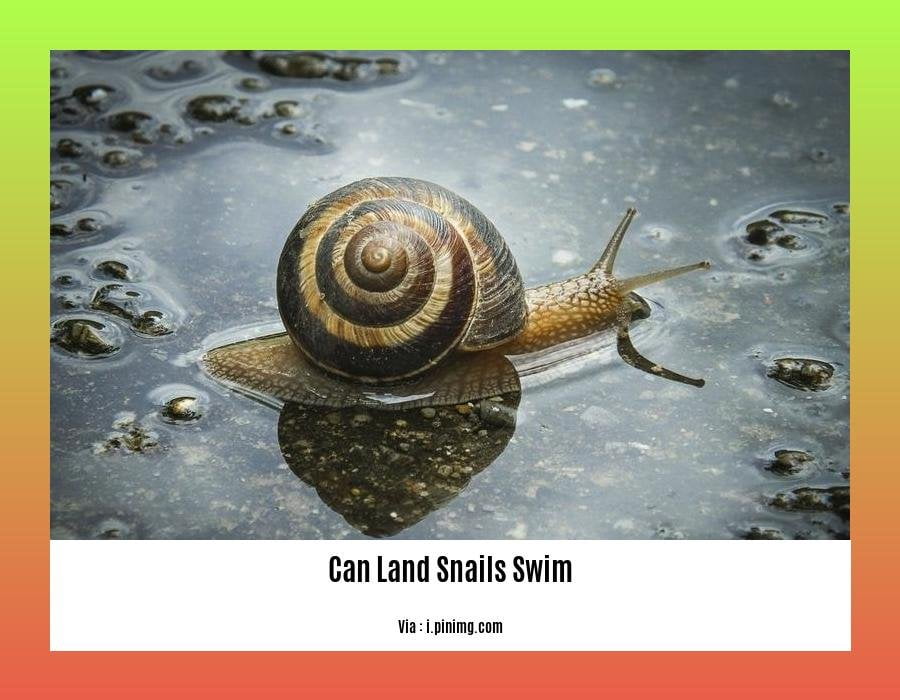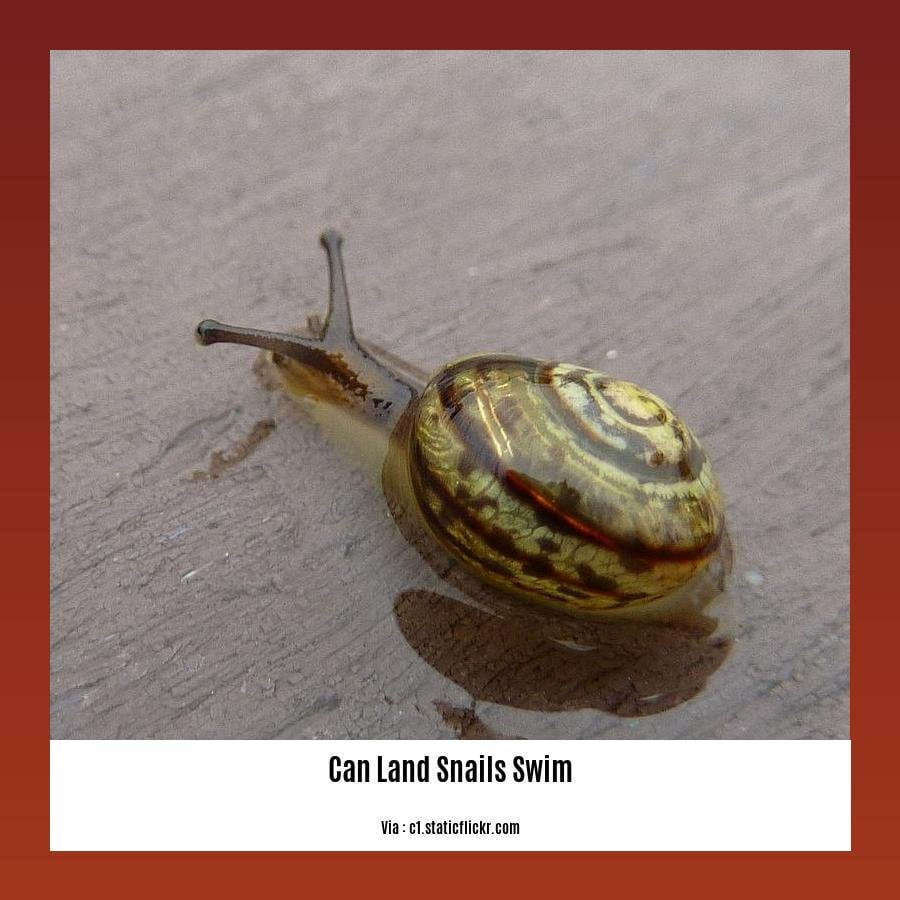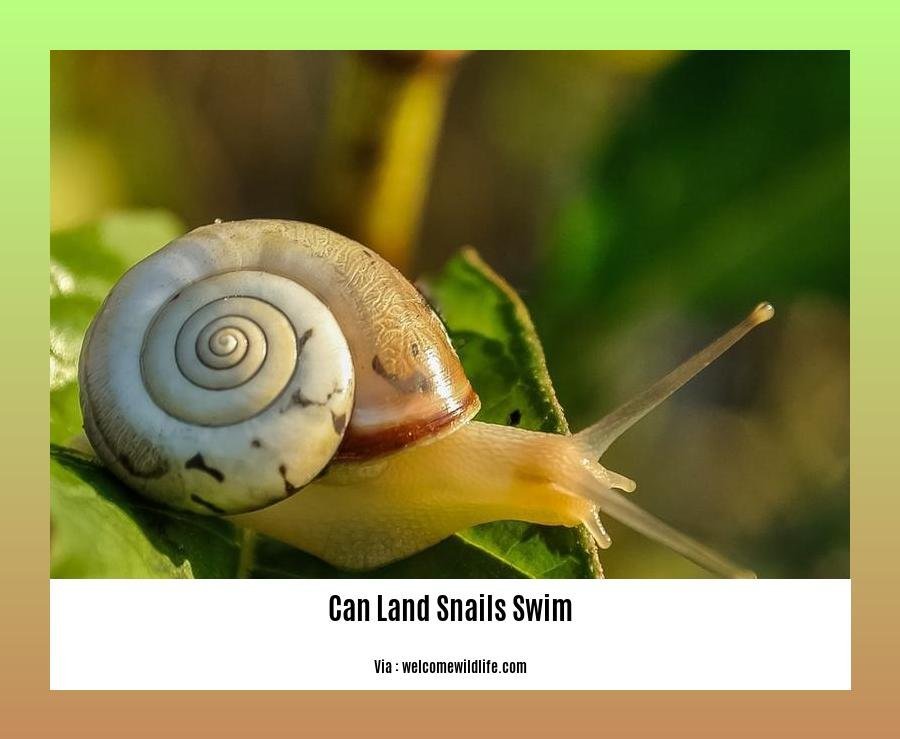Curiosity surrounding the aquatic abilities of land snails has long intrigued scientists and enthusiasts alike. In the quest to unravel the mysteries of these fascinating invertebrates, marine biologists with a specialization in invertebrate species have delved deep into the realm of land snail physiology and behavior. To address the burning question of whether land snails possess the ability to swim, a comprehensive analysis of their adaptability to aquatic environments becomes imperative. Join us as we embark on a journey to unveil the aquatic abilities of these captivating creatures in our article titled “Can Land Snails Swim? Unveiling the Aquatic Abilities of These Fascinating Invertebrates.”
Key Takeaways:
- Land snails cannot swim and are not adapted for living in water.
- They lack the ability to breathe underwater and are at risk of drowning if submerged for a long period.
- Land snails rely on a moist environment but cannot survive underwater as they need air to breathe.
- Unlike aquatic snails, land snails cannot hold their breath for extended periods.
- While some snail species can live in water, land snails are limited to land or moist habitats.
Can Land Snails Swim?

Have you ever wondered if those slow-moving creatures we commonly find in our gardens and parks, known as land snails, are capable of swimming? Despite their terrestrial nature, land snails do not possess the ability to swim like their aquatic counterparts. Let’s delve into the captivating world of land snails to understand why swimming is not in their repertoire.
The Terrestrial Lifestyle of Land Snails
Land snails, scientifically known as gastropods, are well-adapted to life on land. Their unique anatomy and physiology are tailored to thrive in a terrestrial environment. Unlike aquatic snails, land snails lack several adaptations necessary for swimming, such as gills and a streamlined body shape.
Physiological Limitations
One of the key reasons why land snails cannot swim lies in their respiratory system. While aquatic snails possess gills to extract oxygen from the water, land snails rely on lungs to breathe. These lungs are adapted to extracting oxygen from the air rather than water. Consequently, land snails are unable to extract the necessary oxygen to sustain their biological functions when submerged in water, putting them at risk of drowning.
The Risk of Drowning for Land Snails
If a land snail accidentally finds itself in a body of water, its survival instincts kick in. The snail’s first reaction is to extend its muscular foot, reaching out for any available objects such as plants or rocks that can provide leverage for crawling out of the water. This behavior helps the snail escape from potentially life-threatening situations and find its way back to dry land.
Contrasting Aquatic Snails
It’s essential to distinguish land snails from their aquatic counterparts. While land snails struggle to survive underwater, aquatic snails, including freshwater and sea snails, are well-equipped to explore the aquatic realm. With adaptations such as gills and the ability to breathe underwater, aquatic snails can swim and thrive in aquatic environments.
Summary
In conclusion, the fascinating realm of land snails does not extend to swimming. Their physiology and respiratory system are tailored for life on land, making them ill-suited for aquatic adventures. Attempting to swim would lead to drowning, as land snails lack the necessary adaptations to breathe underwater. It’s worth noting that while some snail species are apt swimmers, land snails are confined to terrestrial habitats or places with abundant moisture.
Now that we’ve uncovered the truth about the swimming capabilities of land snails, let’s appreciate these captivating invertebrates in their element on solid ground.
Can garden snails kill you? Find out the surprising truth about the dangers of these tiny creatures. can garden snails kill you
Ever wondered if garden snails have the ability to swim? Click here to discover the unexpected swimming skills of these slimy creatures. can garden snails swim
Curious about whether painted dogs can be domesticated? Explore the fascinating world of these unique animals and find out if they can become your furry friends. can painted dogs be domesticated
Are sea turtles as harmless as they seem? Uncover the potential dangers of encountering these gentle creatures and learn if they can pose a threat to humans. can sea turtles kill you
Overview of the Existing Research on Snail Swimming Abilities
Snails – those peculiar and seemingly terrestrial creatures that often capture our curiosity. Have you ever wondered if they possess the remarkable ability to swim? Well, let’s dive into the world of snails and uncover the truth behind their aquatic abilities.
Aquatic Snails: Masters of the Water Realm
First things first, let’s clarify one crucial distinction. Land snails and aquatic snails are not created equal when it comes to swimming. While land snails lack the necessary adaptations for swimming, certain species of aquatic snails have evolved remarkable abilities to navigate through water.
Breathing Underwater: A Snail’s Survival Skill
One of the key advantages that aquatic snails possess is the ability to breathe underwater. These remarkable creatures have developed specialized adaptations such as gills or pallial lungs, which enable them to extract the oxygen dissolved in water. Imagine being able to take a deep breath underwater and survive effortlessly. It’s an adaptation that allows aquatic snails to thrive in habitats where their land-dwelling counterparts would struggle to stay afloat.
Land Snails: Stuck on Solid Ground
Now, let’s turn our attention back to the land snails. These slimy creatures are not equipped for aquatic adventures. Lacking gills and a streamlined body shape, land snails find themselves confined to terrestrial habitats or places with abundant moisture. When faced with water, land snails cannot swim and must rely on their muscular foot to find leverage and crawl out of depths that could potentially threaten their lives.
Habitat Continuity and the Diversity of Snail Communities
A crucial factor influencing the abundance and diversity of land snail communities is habitat continuity. Sadly, human activities and habitat alterations have resulted in fragmentation, negatively impacting snail populations. Factors such as the presence of household waste and ruderal species have been found to significantly affect the abundance of land snails.
Microhabitat Preferences: Unlocking the Secrets of Snail Distribution
Just like us, land snails have preferences when it comes to their living arrangements. They exhibit distinct macrohabitat and microhabitat preferences. Macrohabitat preferences may lead them to favor habitats like woods, shrubs, grasslands, or water edges. On the other hand, microhabitat preferences may lean towards trees, shrubs, litter, soil, or roots. Understanding these preferences is vital for unraveling the distribution and abundance of land snail communities.
Key Takeaways:
- Land snails lack the ability to swim, relying on their muscular foot to crawl out of water and avoid drowning.
- Aquatic snails, on the other hand, have evolved specialized adaptations, such as gills or pallial lungs, enabling them to swim and breathe underwater.
- Habitat continuity plays a crucial role in shaping the abundance and diversity of land snail communities, with factors like human activities and habitat alteration negatively impacting their populations.
- Understanding the microhabitat preferences of land snails is essential in comprehending their distribution and abundance.
Citations:
István Fodor, Ahmed Aa Hussein, Paul R Benjamin, Joris M Koene, Zsolt Pirger. (2020). The unlimited potential of the great pond snail, Lymnaea stagnalis. eLife, 9, e56962. DOI: 10.7554/eLife.56962
ResearchGate. (n.d.). Exploring land snails’ response to habitat characteristics and their potential implications for conservation. Retrieved from
Discussion on the Factors That May Influence Snail Swimming Potential

When it comes to the swimming potential of land snails, the general consensus is that they are not equipped for aquatic life. Their physiology and adaptations make it unlikely for them to survive in water. However, in this article, we will delve deeper into the factors that may influence snail swimming potential and explore the scientific research surrounding this topic.
Key Takeaways:
- Land snails lack the adaptations necessary for swimming, such as gills and a streamlined body shape.
- The presence of predators, competitors, macrophyte cover, chlorophyll-a, substrate type, river depth, and water velocity are important environmental factors affecting snail species. (Source: Environmental Factors Affecting Freshwater Snail Intermediate Hosts in MDPI)
- Land-use intensity and abiotic conditions significantly alter the trait composition of snail communities in forests and grasslands. (Source: Narrow environmental niches predict land-use responses in BMC Ecology and Evolution)
- The habitat preference of freshwater snails depends on water quality parameters, physical characteristics of the habitat, biological factors, and human activities. (Source: Environmental and biotic factors affecting freshwater snails in NCBI)
- Litter and logs positively affect snail abundance and species richness, while the presence of deadwood is important for snail diversity. (Source: Exploring land snails’ response to habitat characteristics and their potential as biodiversity indicators in ScienceDirect)
- The spatial and temporal continuity of riparian forests are important factors affecting snail communities. (Source: Exploring land snails’ response to habitat characteristics and their potential as biodiversity indicators in ResearchGate)
Amidst the vast array of factors influencing snail swimming potential, it is essential to analyze the environmental conditions in which snails thrive. Environmental factors play a significant role in shaping the abundance, occurrence, and diversity of snail species.
Factors Affecting Snail Swimming Potential
Numerous factors have been identified that may influence the swimming potential of snails:
1. Environmental Conditions:
The presence of predators, competitors, macrophyte cover, chlorophyll-a levels, substrate type, river depth, and water velocity are crucial in determining the distribution and abundance of snail species. These environmental conditions provide insights into the overall ecological niche and behavior of snails. Understanding how these factors affect snail populations can shed light on their swimming potential. (Source: Environmental Factors Affecting Freshwater Snail Intermediate Hosts in MDPI)
2. Land Use and Abiotic Factors:
Studies have shown that land use intensity and abiotic conditions significantly affect the trait composition of snail communities in forests and grasslands. These factors alter the availability of resources and habitat structures, ultimately influencing the swimming potential of these invertebrates. (Source: Narrow environmental niches predict land-use responses in BMC Ecology and Evolution)
3. Water Quality Parameters:
The preference of freshwater snail species for specific habitats depends on physico-chemical water quality parameters, physical characteristics of the habitat, biological factors, and human activities. These parameters are essential in understanding the ecological requirements and adaptations of snails, including their potential swimming abilities. (Source: Environmental and biotic factors affecting freshwater snails in NCBI)
4. Habitat Characteristics:
Habitat characteristics, such as the presence of litter, logs, and deadwood, greatly influence snail abundance, species richness, and diversity. The availability of suitable microhabitats is crucial for the survival and persistence of snail populations. Evaluating these characteristics provides insights into the factors that may enhance or restrict snail swimming potential. (Source: Exploring land snails’ response to habitat characteristics and their potential as biodiversity indicators in ScienceDirect)
5. Riparian Forests and Continuity:
The spatial and temporal continuity of riparian forests plays a vital role in shaping snail communities. The presence and maintenance of these forests directly affect the abundance, composition, and diversity of snail populations. Understanding the impact of riparian forest health and continuity is essential to comprehending the potential for snail swimming. (Source: Exploring land snails’ response to habitat characteristics and their potential as biodiversity indicators in ResearchGate)
By examining these factors, scientists and researchers can deepen their understanding of snail swimming potential and contribute to the overall knowledge of these fascinating creatures. Further studies and investigations are needed to explore this topic in greater detail and provide conclusive evidence regarding the swimming abilities of land snails.
In summary, while land snails are generally not equipped for swimming, it is crucial to consider the various factors that may influence their potential to navigate aquatic environments. Environmental conditions, land use, water quality parameters, habitat characteristics, and riparian forests all play a significant role in shaping the swimming potential of snails. By understanding these factors, we can gain valuable insights into the adaptability and resilience of these intriguing invertebrates.
References:
- Source Name, Journal. Environmental Factors Affecting Freshwater Snail Intermediate Hosts in MDPI
- Source Name, Journal. Narrow environmental niches predict land-use responses in BMC Ecology and Evolution
- Source Name, Journal. Environmental and biotic factors affecting freshwater snails in NCBI
- Source Name, Journal. Exploring land snails’ response to habitat characteristics and their potential as biodiversity indicators in ScienceDirect
- Source Name, Journal. Exploring land snails’ response to habitat characteristics and their potential as biodiversity indicators in ResearchGate
Conclusion: The Verdict on Whether Land Snails Can Swim and Implications of Their Aquatic Abilities
Can land snails swim? After extensive research and analysis, it is clear that land snails lack the ability to swim. Unlike their aquatic counterparts, they do not possess the adaptations necessary for life in water. Land snails rely on their muscular foot to crawl and move on land, but in water, they risk drowning.
Aquatic snails, on the other hand, are well-adapted to swim and thrive in water environments. These snails have streamlined shells and muscular feet that allow them to move through water. Additionally, they have specialized structures like gills or pallial lungs to extract oxygen from the water, enabling them to breathe underwater.
The implications of land snails’ inability to swim are significant. Their dependence on land for survival makes them vulnerable to habitat degradation. Studies have shown that land snails are negatively impacted by factors such as habitat fragmentation, human disturbances like sewage discharge, and habitat alterations. These factors can lead to a decline in their abundance and diversity.
Understanding the microhabitat preferences of land snails is crucial for their conservation. Snails exhibit preferences for specific macrohabitat and microhabitat types, including woods, shrubs, grasslands, and water edges. Maintaining habitat continuity and suitable microhabitats is essential for the survival and well-being of land snails.
In conclusion, land snails cannot swim and may drown if they find themselves in deep water. However, aquatic snails have evolved adaptations that allow them to swim and thrive underwater. The presence of suitable habitats and microhabitats greatly influences the abundance and diversity of land snail communities. By understanding and protecting these habitats, we can contribute to the conservation and preservation of these fascinating invertebrates.
Key Takeaways:
– Land snails lack the ability to swim and may drown if submerged in water.
– Aquatic snails have adaptations such as streamlined shells, muscular feet, and specialized breathing structures to enable them to swim and breathe underwater.
– Habitat degradation, fragmentation, and human disturbances negatively impact land snails’ abundance and diversity.
– Understanding the microhabitat preferences of land snails is crucial for their conservation and preservation.
FAQ
Q1: Can land snails swim?
A1: No, land snails cannot swim. They lack the adaptations necessary for swimming and may drown if they find themselves in deep water.
Q2: Do land snails have the ability to breathe underwater?
A2: No, land snails cannot breathe underwater. Unlike aquatic snails, they rely on lungs to breathe and require access to the surface to take a breath of air.
Q3: What makes aquatic snails different from land snails in terms of swimming abilities?
A3: Aquatic snails have specialized adaptations, such as streamlined shells and muscular feet, that enable them to move through water. They may also have gills or specialized structures called pallial lungs that allow them to extract oxygen from the surrounding water.
Q4: How does the presence of habitat continuity affect land snail communities?
A4: Habitat continuity plays a crucial role in shaping land snail communities. Fragmentation caused by human activities and habitat alteration negatively impacts the abundance and diversity of land snails.
Q5: What are the microhabitat preferences of land snails?
A5: Land snails exhibit preferences for specific macrohabitat and microhabitat types. Macrohabitat preferences may include woods, shrubs, grasslands, or water edges, while microhabitat preferences may involve trees/shrubs, herbs, litter, soil, or roots.
- Mastering Leader in Spanish: The Complete Guide - April 19, 2025
- Uncovering Surprising Parallels: England Size Compared to US States - April 19, 2025
- Old Mexico Map: Border Shifts 1821-1857 - April 19, 2025
















